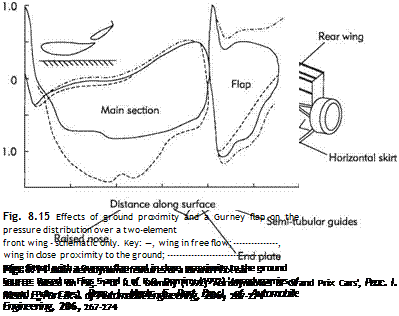Use of multi-element aerofoils on racing cars
In the 1960s and early 1970s several catastrophic accidents occurred in which racing cars became airborne. In some cases aerodynamic interference from nearby competing vehicles was undoubtedly a factor. Nevertheless, these accidents are a grim reminder of what can happen to a racing car if insufficient aerodynamic downforce is generated. Modern Grand Prix cars generate their prodigious aerodynamic downforces from two main sources, namely ‘ground effect’ and inverted wings. Under current Formula-One rules the undertray of the car must be completely flat between the front and rear wheels. This severely limits the ability of the racing-car designer to exploit ground effect for generating downforce.[59]
Inverted wings, mounted in general above the front and rear axles (Fig. 8.14), first began to appear on Formula-One cars in 1968. The resultant increase in the downward force between the tyre and road immediately brought big improvements in cornering, braking and traction performance. The front wing is the most efficient aerodynamic device on the car. Except when closely following another car, this wing operates in undisturbed airflow, so there is nothing preventing the use of conventional aerofoils to generate high downforce (negative lift) with a relatively small drag. If the wing is located close to the ground the negative lift is further enhanced owing to increased acceleration of the air between the bottom of the wing and the ground, leading to lower suction pressure. (Fig. 8.15.) However, if the ground clearance is too small, the adverse pressure gradient over the rear of the wing becomes more severe, resulting in stall. Even if stall is avoided, too close a proximity to the ground may result in large and uncontrollable variations in downforce when there are unavoidable small changes in ride height due to track undulations or to roll and pitch of the vehicle. Sudden large changes in downward force that are inevitably accompanied by sudden changes to the vehicle’s centre of pressure could make the car extremely difficult to drive. Racing-car designers must therefore compromise between optimum aerodynamic efficiency and controllability.
Under Formula-One rules the span of each wing is limited, so that the adverse three-dimensional effects found with wings of low aspect ratio are relatively severe. One of these adverse effects is the strong reduction in the spanwise lift distribution from root to tip. A common solution to this problem is to use plane end-plates, as illustrated in Fig. 8.14; these help keep the flow quasi-two-dimensional over the
 |
entire span. End-plates do not eliminate the generation of strong wing-tip vortices which have other undesirable effects. Consequently, semi-tubular guides along the lower edges of the end-plates are often used in an attempt to control these vortices (see Fig. 8.14). It can also be seen in Fig. 8.14 that the front wing comprises a main wing and a flap. The chord and camber of the flap are very much greater over its outer section compared with inboard. This arrangement is adopted in order to reduce
the adverse effects of the front wing’s wake on the cooling air entering the radiator intakes.
The rear wing has to operate in the vehicle’s wake. So the generation of high downforce by the rear wing is inevitably much less efficient than for the front wing. The car’s wake is a highly unsteady, turbulent flow containing complex vortical flow structures. As a consequence, the effective angle of incidence along the leading edge of the rear wing may vary by up to 20°. Also the effective onset speeds may be much reduced compared with the front wings, further impairing aerodynamic efficiency. Despite all these problems, in order to maintain the required position for the centre of pressure, the design engineers have to ensure that the rear wing generates more than twice the downforce of the front wings. This is achieved by resorting to the sort of highly cambered, multi-element, aerofoils deployed by aircraft wings for landing. The high drag associated with the rear wing places severe limits on the top speed of the cars. But the drag penalty is more than offset by the much higher cornering speeds enabled by the increased downforce.











